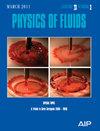基于分数衍生理论的嵌入树状分支网络中幂律流体的分形渗透率模型
IF 4.1
2区 工程技术
Q1 MECHANICS
引用次数: 0
摘要
对树状分支网络渗透性的研究已引起广泛关注。然而,有关预测树状分支网络渗透性的分形模型的研究大多包含经验常数。本文研究了幂律流体在嵌入式树状分支网络多孔介质双孔隙度模型中的流动特性。考虑到幂律流体的固有特性、非牛顿行为效应以及多孔介质的分形特性,基于分形-派生理论和分形理论引入了幂律流体流变方程。然后,推导出预测双多孔介质中幂律流体有效渗透率的解析公式。该分析公式指出了分形尺寸和结构参数对渗透率的影响。随着长度比、分叉序列和分叉角的增大,以及幂律指数和直径比的减小,有效渗透率会出现不同程度的下降。推导出的分析模型不包含经验常数,符合幂律流体的非牛顿特性,表明该模型是描述自然系统和工程中复杂非牛顿流体在多孔介质中流动过程的有效方法。因此,本研究对于推导内嵌树状分叉网络中幂律流体渗透率的解析解具有重要意义。本文章由计算机程序翻译,如有差异,请以英文原文为准。
Fractal permeability model for power-law fluids in embedded tree-like branching networks based on the fractional-derivative theory
The investigation of permeability in tree-like branching networks has attracted widespread attention. However, most studies about fractal models for predicting permeability in tree-like branching networks include empirical constants. This paper investigates the flow characteristics of power-law fluids in the dual porosity model of porous media in embedded tree-like branching networks. Considering the inherent properties of power-law fluids, non-Newtonian behavior effects, and fractal properties of porous media, a power-law fluids rheological equation is introduced based on the fractional-derivative theory and fractal theory. Then, an analytical formula for predicting the effective permeability of power-law fluids in dual porous media is derived. This analytical formula indicates the influences of fractal dimensions and structural parameters on permeability. With increasing length ratio, bifurcation series, and bifurcation angle, as well as decreasing power-law exponent and diameter ratio, the effective permeability decreases to varying degrees. The derived analytical model does not include empirical constants and is consistent with the non-Newtonian properties of power-law fluids, indicating that the model is an effective method for describing the flow process of complex non-Newtonian fluids in porous media in natural systems and engineering. Therefore, this study is of great significance to derive analytical solutions for the permeability of power-law fluids in embedded tree-like bifurcation networks.
求助全文
通过发布文献求助,成功后即可免费获取论文全文。
去求助
来源期刊

Physics of Fluids
物理-力学
CiteScore
6.50
自引率
41.30%
发文量
2063
审稿时长
2.6 months
期刊介绍:
Physics of Fluids (PoF) is a preeminent journal devoted to publishing original theoretical, computational, and experimental contributions to the understanding of the dynamics of gases, liquids, and complex or multiphase fluids. Topics published in PoF are diverse and reflect the most important subjects in fluid dynamics, including, but not limited to:
-Acoustics
-Aerospace and aeronautical flow
-Astrophysical flow
-Biofluid mechanics
-Cavitation and cavitating flows
-Combustion flows
-Complex fluids
-Compressible flow
-Computational fluid dynamics
-Contact lines
-Continuum mechanics
-Convection
-Cryogenic flow
-Droplets
-Electrical and magnetic effects in fluid flow
-Foam, bubble, and film mechanics
-Flow control
-Flow instability and transition
-Flow orientation and anisotropy
-Flows with other transport phenomena
-Flows with complex boundary conditions
-Flow visualization
-Fluid mechanics
-Fluid physical properties
-Fluid–structure interactions
-Free surface flows
-Geophysical flow
-Interfacial flow
-Knudsen flow
-Laminar flow
-Liquid crystals
-Mathematics of fluids
-Micro- and nanofluid mechanics
-Mixing
-Molecular theory
-Nanofluidics
-Particulate, multiphase, and granular flow
-Processing flows
-Relativistic fluid mechanics
-Rotating flows
-Shock wave phenomena
-Soft matter
-Stratified flows
-Supercritical fluids
-Superfluidity
-Thermodynamics of flow systems
-Transonic flow
-Turbulent flow
-Viscous and non-Newtonian flow
-Viscoelasticity
-Vortex dynamics
-Waves
 求助内容:
求助内容: 应助结果提醒方式:
应助结果提醒方式:


